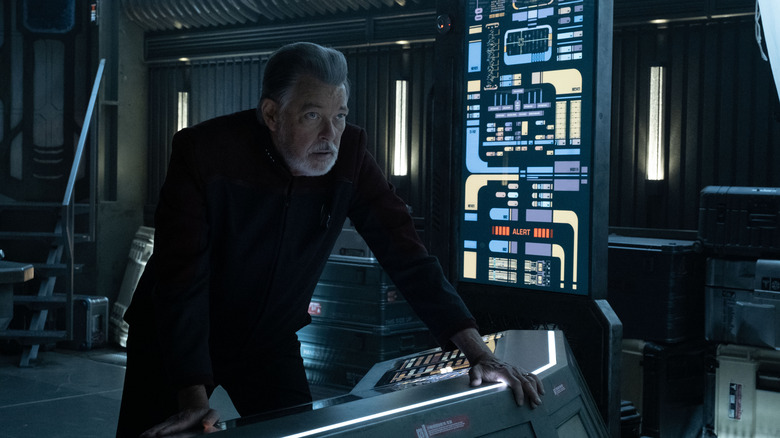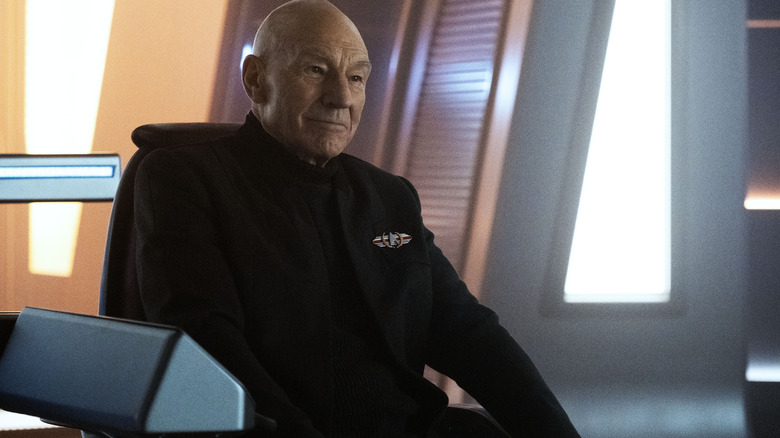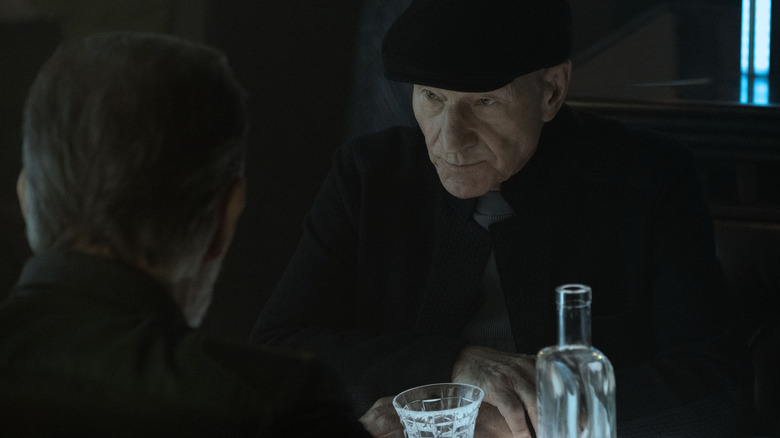There's A Real Wrath Of Khan Energy To Star Trek: Picard Season 3, In More Ways Than One
This Trekkie is old enough to recall the rise of "Star Trek II: The Wrath of Khan." While Nicholas Meyer's 1982 sequel was always celebrated, it wasn't until the release of "Star Trek VI: The Undiscovered Country" in 1991 — reportedly the final film to feature the original cast of 1966's "Star Trek" — that an unofficial permanent quality ranking began to form. It was at this time that the popular "even-odd" theory began to develop, a criticism that dictated the even-numbered Trek films were good, and the odd-numbered ones were bad. This theory would continue to prove true, however, with the release of "Star Trek: Generations," "Star Trek: First Contact," and "Star Trek: Insurrection" in 1994, 1996, and 1998 respectively. It wouldn't be until 2002's bomb "Star Trek: Nemesis" that the pattern would be broken.
In that precious window after 1991, "Wrath of Khan" was declared more or less as the best film in the series, with many citing its outsize villain (played by Ricardo Montalbán) and notable submarine-like climactic starship battle the film's primary impressive elements. Personally, I prefer the slow, cerebral "Star Trek: The Motion Picture" and the socio-political "Undiscovered Country" as my favorites, but "Wrath of Khan" is still pretty unassailable.
Because of the long-held veneration of "Khan," however, several Trek movies since have tried to replicate its formula. This would explain why so many of the feature films tend to be about powerful, revenge-based villains — villains who often have a personal connection to one of the Enterprise crew members — and why they tend to feature action over negotiation. This was a formula employed in all the films since "Nemesis."
It's also something the new season of "Star Trek: Picard" is doing unapologetically.
What a drag it is, getting old
The third episode of the new season of "Picard" is called "Seventeen Seconds." It features a deranged, wicked villain — in this case, the evil Vadic, played by Amanda Plummer — following a Starfleet vessel into a mysterious nebula where communication will be limited and sensors will be deactivated. She pilots a massively overpowered battle vessel called the Shrike, which leaves the U.S.S. Titan utterly outmatched. The two ships will have trouble seeing each other and aiming their weapons, making pass-bys infrequent and each shot particularly damaging. This is all lifted directly from "Wrath of Khan," of course, and — if we're being honest — is still effective.
But it's not just the battle that mirrors "Khan." It's the entire thrust of the season.
Picard (Patrick Stewart) is about a century old in this season, and he says in the first episode that he is not yet ready to be remembered for his legacy, aching for more adventure. The adventure comes when Dr. Crusher (Gates McFadden) sends him a secret message asking for defense against evil villains who would kidnap her adult son Jack (Ed Speelers). The season follows Picard's reunification with Riker (Jonathan Frakes) and their mutual understanding that they are no longer spring chickens.
One might recall that Kirk (William Shatner) was gifted a pair of reading glasses in "Khan," giving the character a physical symbol of his aging. His eyes aren't what they used to be, and he'll never again be the young buck of previous decades. Aging is a major theme of both "Picard" and "Khan." Authority remains, but it may be flagging.
Another major theme of "Star Trek II," one might recall, is that of consequences. Kirk and Picard both have repairs to do.
The past returning to haunt you
Kirk was quite cavalier back in the day. In one episode, he destroyed a computer named Landru that was controlling the minds of distant colonists. In another, he destroyed a computer named Vaal that was ... was controlling the minds of distant aliens. Most significantly, in the episode "Space Seed" (February 16, 1967), Kirk first met Khan, a cryogenically frozen tyrant left over from Earth's Eugenics Wars. Khan, armed with intelligence and charisma, gathered his old compatriots and threatened to take the Enterprise from Kirk. Kirk managed to talk Khan into settling on an uninhabited planet instead, posing it as a challenge to form a new, superior society from scratch. Khan took him up on the deal, and he left peacefully.
"Star Trek II" reveals that a massive cataclysm hit the planet where Khan was staying, turning it into a lifeless desert world. Kirk never bothered to check up on Khan, and the tyrant, barely surviving, turned into a supervillain as a result. He fled the desert world seeking revenge on Kirk, a man who long forgot his past involvement with Khan.
"Picard," meanwhile, seems to be delving into the past of its title character by giving him a long-lost son. Picard and Dr. Crusher had an affair some 25 years prior, and now Picard — ordinarily alone and openly loathing of children — now has to face the fact that his affairs have left behind both a child and some bitter resentments. Not everything will always be within the character's control.
While "Picard" may now be emulating "Khan," it is, at the very least, doing so in a way that is appropriate for the characters. The references, it seems, are more cute and traditional than nostalgia bait. For that, we can be grateful.


